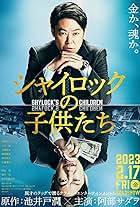Ito has a husband and three children. Life is difficult and food is expensive. Rice, which is a staple of their diet, is expensive and becoming more dear by the week. Needing to feed themsel... Read allIto has a husband and three children. Life is difficult and food is expensive. Rice, which is a staple of their diet, is expensive and becoming more dear by the week. Needing to feed themselves, the villagers pick up whatever labour they can. The women of the village are at their... Read allIto has a husband and three children. Life is difficult and food is expensive. Rice, which is a staple of their diet, is expensive and becoming more dear by the week. Needing to feed themselves, the villagers pick up whatever labour they can. The women of the village are at their wits' end and take action.
Photos
- Director
- Writers
- All cast & crew
- Production, box office & more at IMDbPro
Storyline
Did you know
- TriviaThe film was part of the line-up at Toronto Japanese Film Festival (TJFF) in Toronto, Canada in 2021.
Unfortunately, Angry Rice Wives was disappointing. While it would be a stretch to call it a bad film, a combination of poor acting, superficial treatment by the script and inconsistencies made for an indifferent watch. Moreover, having seen the star Inoue Mao in The Eternal Zero one would be forgiven for expecting more from her. While she was largely side-lined in that film, there was no indication her acting is as one-dimensional as her skin deep expression and monotonous gaze in this film.
Motoki and Inoue have also worked together before and should know what to expect from one another.
Given the period and the social class the film zooms in on the actresses who are largely transformed and unrecognizable. Their faces are sunburnt, haggard and unhappy, their backs hunched and their lives pitiful and desperate as they seek to stave off hunger and feed their families. Yet, much of it is not as fiery as one would expect and their expressions, endeavours and circumstances simply not believable. Men are off to Hokkaido or Karafuto to fish in the off-season and the women are left behind to toil, take care of the household and survive. Our heroine Ito has a house, three children and a mother to handle while she carries bale after bale from the warehouse to the boats. The first time the women march with anger and indignation no one spares them a glance. For some reason the second time the group marches everyone in town stops, stares and looks flabbergasted. It is inconsistent. Indeed, one or two of the women rushing a boat in a beach scene looked like they are laughing and are bemused instead of angry and determined. The police arriving within twenty seconds does not help with the scene's credibility either. Neither does the obviously fake ship off the coast nor the dejected reporter who wanted to change the world (by reporting on this incident).
These are poor people, but when a woman brings a free fish it falls on the ground and no one picks it up. Then there is obviously enough kelp for a poor woman to hand out for free. These are destitute people, but generally look too plump and healthy and carry their bales with too much conviction to truly be impoverished. The streets and the folks' clothes are too neat and clean. The feminism, which in a special video recording the director notes is important to his film, too is ham-fisted. There is a little girl who declares she hates the police as an older man touches and ogles her. A teen girl declares she is done with letting men control her life and, in order to not depend on men any longer, has decided to shuffle off and work as a geisha! Hey, as long as it is not this reviewer who has to explain to her what the job description of a geisha includes. Never mind that the prerequisite for such a vocation is years of training. It is fine as a feminist credo to improve one's lot in life, but instances like this make the film look cheap.
Indeed, and as mentioned, this film is not bad and it was an amusing watch given the subject matter, inclusive of the collusion of the merchant class with the warmongering government, setting and original idea, but a few questions did come to my mind. Why are the human mules needed in the first place? Even if no beasts of burden are available, could the townspeople, merchants and government not build or procure carts at least? Why the presence of the occasional visible narrator who intermittently talks to the screen or nobody in particular? Perhaps the director wanted to introduce the concept of a Benshi, which was popular in Japan during the riots' period, but then why do it only here and there? Finally, the film's original title is 'The Great Rice Riots.' Somehow someone in translation decided that the script, including several overt monologues (and even a pertinent speech against the system by a man on a soapbox) is insufficient feminism and the film's title became Angry Rice Wives in Canada.
Details
- Runtime1 hour 46 minutes
- Color
- Aspect ratio
- 1.85 : 1
Contribute to this page








